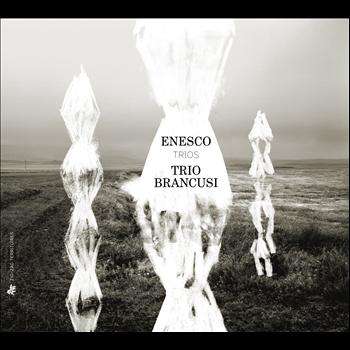|
Back
06/06/2012
Georges Enescu: Trio in g minor (world premiere recording) – Sérénade lointaine – Trio in a minor
Trio Brancusi: Mara Dobresco (piano), Saténik Khourdoïan (violin), Laura Buruiana (violoncello)
Recorded at the Eglise de Bon Secours, Paris (March 7-11, 2011) – 53’
Zig-Zag Territoires CD ZZT303 – Booklet in French and English with Photos and Program Notes

   
George Enescu has in many ways shared the same fate as Franz Liszt, Sergei Rachmaninoff, and Ferruccio Busoni, and that is the fact that his being an extraordinary virtuoso performer, both on the violin and the piano, has completely overshadowed the fact that he was also a gifted and inspired composer. It is only now that many of his best compositions, such as his opera Œdipe, are seeing the light of day, and very slowly entering into the international repertory. In fact only about one half of his compositions, which number around 100 works, were actually published during his lifetime.
Enescu began his musical studies as a child prodigy in an extensive curriculum of piano, violin, composition, and history at the Gesellschatt der Musikfreunde in Vienna. He was only fifteen in 1896 when he entered the Paris Conservatory. His principal teachers and mentors there being Jules Massenet and Gabriel Fauré.
George Enescu was subsequently to develop an extensive career not only as a pianist and violinist, but also as a conductor who founded many orchestras in Romania, France, and the United States. He also trained some of the leading violinists of his day; his most famous pupils being Yehudi Menuhin, Christian Ferras, and Arthur Grumiaux.
I am relating all of this history to give you an understanding of why his recognition as a major composer has become so obscured. In fact it was Yehudi Menuhin who predicted that Enescu’s compositions would be one of the great discoveries of the 21st Century.
And indeed, it is so! The Trio in g minor (no Opus numbers are given on this recording or in the program notes) was thought to be lost for over a century until the parts were recently discovered in Paris, probably from a performance given in 1898. This trio shows a heavy influence from his early days in Vienna. The dramatic and flamboyant introduction immediately calls to mind the Piano Quintet of Robert Schumann. The large and romantic scope of this trio displays a heavy influence of the compositional style of Johannes Brahms, especially in Enescu’s scoring for the piano.
The Sérénade lointaine is an obvious homage to the elegiac style of Massenet. It also resembles many similar compositions by Tchaikovsky or Grieg in its melancholic and nostalgic salon style of writing. I would predict that as this melodically memorable piece becomes better known, and enters into the standard repertoire, that it will become a very popular piece with the general public much in the same way as Tchaikovsky’s None but the Lonely Heart or Massenet’s Elégie.
The manuscript of the Trio in a minor was discovered in 1965 and bears the unmistakable stamp of Enescu’s later compositional style, which is the use of characteristic Romanian folk melodies and rhythms, a rhapsodic and greater freedom of form, the employment of an harmonic language at the other end of the spectrum, and a systematic chromaticism in thematic transformation, which is encountered more frequently in the music of Liszt and Wagner. The sharp and angular rhythms of this trio combined with the folk elements give the impression of a wild dance of Transylvanian gypsies and points the way to early Bartok and Kodaly. Well, at least to my ears it does, and as this music has never heard until now, one must rely on their own impressions, ...n’est-ce pas?
The Trio Brancusi is an all-female ensemble, and they can boast themselves as well as a truly virtuoso ensemble. They fly through this very difficult music with great aplomb and bravura, articulating the rather vicious string and piano passages with amazing ease and dexterity. All three women being Romanian have an inborn and natural instinct for Enescu’s style and his incorporation of the Romanian folk elements. There could not possibly be better ambassadors for this music than the Trio Brancusi. Ms. Khourdoïan’s often alarming virtuosity on the violin is wonderfully thrilling. Ms. Dobresco’s brilliance on the piano is equally dazzling, not only in the bravura passages, but in the nostalgic vocal lines as well. Ms. Buruiana’s cello voicing captures the profound resonance of a deep contralto. It is perhaps her sound throughout that gives the ensemble its unique color and distinctive sonority.
There are many fine reasons to recommend this recording, but the best selling points are the facts that the music is completely unfamiliar and immediately captivating, enjoyable, and memorable. The recorded sound is unusually warm and “close”, and the performances by Trio Brancusi are a celebration of this music. George Enescu is a composer you need to acquaint yourself with, and this recording is an excellent introduction.
The Brancusi Trio
Micaele Sparacino
|